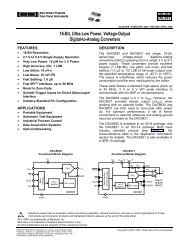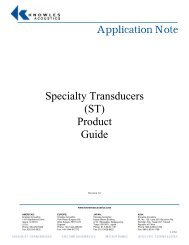AD7714* 3 V/5 V, CMOS, 500 µA Signal Conditioning ADC - dreamm
AD7714* 3 V/5 V, CMOS, 500 µA Signal Conditioning ADC - dreamm
AD7714* 3 V/5 V, CMOS, 500 µA Signal Conditioning ADC - dreamm
Create successful ePaper yourself
Turn your PDF publications into a flip-book with our unique Google optimized e-Paper software.
AD7714<br />
ANALOG INPUT<br />
Analog Input Ranges<br />
The AD7714 contains six analog input pins (labelled AIN1 to<br />
AIN6) which can be configured as either three fully differential<br />
input channels or five pseudo-differential input channels. Bits<br />
CH0, CH1 and CH2 of the Communications Register configure<br />
the analog input arrangement and the channel selection is as<br />
outlined previously in Table VII. The input pairs (either differential<br />
or pseudo-differential) provide programmable-gain, input<br />
channels which can handle either unipolar or bipolar input signals.<br />
It should be noted that the bipolar input signals are referenced<br />
to the respective AIN(–) input of the input pair.<br />
In unbuffered mode, the common mode range of these inputs is<br />
from AGND to AV DD provided that the absolute value of the<br />
analog input voltage lies between AGND – 30 mV and<br />
AV DD + 30 mV. This means that in unbuffered mode the part<br />
can handle both unipolar and bipolar input ranges for all gains.<br />
In buffered mode, the analog inputs can handle much larger<br />
source impedances, but the absolute input voltage range is<br />
restricted to between AGND + 50 mV to AV DD – 1.5 V which<br />
also places restrictions on the common-mode range. This means<br />
that in buffered mode there are some restrictions on the allowable<br />
gains for bipolar input ranges. Care must be taken in setting<br />
up the common-mode voltage and input voltage range so<br />
that the above limits are not exceeded, otherwise there will be a<br />
degradation in linearity performance.<br />
In unbuffered mode, the analog inputs look directly into the<br />
7 pF input sampling capacitor, C SAMP . The dc input leakage<br />
current in this unbuffered mode is 1 nA maximum (A Version)<br />
and 10 nA maximum (S Version). As a result, the analog inputs<br />
see a dynamic load which is switched at the input sample rate<br />
(see Figure 3). This sample rate depends on master clock frequency<br />
and selected gain. C SAMP is charged to AIN(+) and discharged<br />
to AIN(–) every input sample cycle. The effective<br />
on-resistance of the switch, R SW , is typically 7 kΩ.<br />
AIN(+)<br />
AIN(–)<br />
R SW (7kΩ TYP)<br />
C SAMP<br />
(7pF )<br />
V BIAS<br />
SWITCHING FREQUENCY DEPENDS ON<br />
f CLKIN AND SELECTED GAIN<br />
HIGH<br />
IMPEDANCE<br />
>1GΩ<br />
Figure 3. Unbuffered Analog Input Structure<br />
C SAMP must be charged through R SW and through any external<br />
source impedances every input sample cycle. Therefore, in unbuffered<br />
mode, source impedances mean a longer charge time<br />
for C SAMP and this may result in gain errors on the part. Table<br />
XII shows the allowable external resistance/capacitance values,<br />
for unbuffered mode, such that no gain error to the 16-bit level<br />
is introduced on the part. Table XIII shows the allowable external<br />
resistance/capacitance values, once again for unbuffered<br />
mode, such that no gain error to the 20-bit level is introduced.<br />
Gain<br />
Table XII. External R, C Combination for No 16-Bit Gain<br />
Error (Unbuffered Mode Only)<br />
External Capacitance (pF)<br />
0 50 100 <strong>500</strong> 1000 <strong>500</strong>0<br />
1 368 kΩ 90.6 kΩ 54.2 kΩ 14.6 kΩ 8.2 kΩ 2.2 kΩ<br />
2 177.2 kΩ 44.2 kΩ 26.4 kΩ 7.2 kΩ 4 kΩ 1.12 kΩ<br />
4 82.8 kΩ 21.2 kΩ 12.6 kΩ 3.4 kΩ 1.94 kΩ 540 Ω<br />
8–128 35.2 kΩ 9.6 kΩ 5.8 kΩ 1.58 kΩ 880 Ω 240 Ω<br />
Table XIII. External R, C Combination for No 20-Bit Gain<br />
Error (Unbuffered Mode Only)<br />
Gain<br />
External Capacitance (pF)<br />
0 50 100 <strong>500</strong> 1000 <strong>500</strong>0<br />
1 290 kΩ 69 kΩ 40.8 kΩ 10.4 kΩ 5.6 kΩ 1.4 kΩ<br />
2 141 kΩ 33.8 kΩ 20 kΩ 5 kΩ 2.8 kΩ 700 Ω<br />
4 63.6 kΩ 16 kΩ 9.6 kΩ 2.4 kΩ 1.34 kΩ 340 Ω<br />
8–128 26.8 kΩ 7.2 kΩ 4.4 kΩ 1.1 kΩ 600 Ω 160 Ω<br />
In buffered mode, the analog inputs look into the high impedance<br />
inputs stage of the on-chip buffer amplifier. C SAMP is<br />
charged via this buffer amplifier such that source impedances do<br />
not affect the charging of C SAMP . This buffer amplifier has an<br />
offset leakage current of 1 nA. In this buffered mode, large<br />
source impedances result in a dc offset voltage developed across<br />
the source impedance but not in a gain error.<br />
Input Sample Rate<br />
The modulator sample frequency for the AD7714 remains at<br />
f CLK IN /128 (19.2 kHz @ f CLK IN = 2.4576 MHz) regardless of<br />
the selected gain. However, gains greater than 1 are achieved<br />
by a combination of multiple input samples per modulator cycle<br />
and a scaling of the ratio of reference capacitor to input capacitor.<br />
As a result of the multiple sampling, the input sample rate<br />
of the device varies with the selected gain (see Table XIV). In<br />
buffered mode, the input is buffered before the input sampling<br />
capacitor. In unbuffered mode, where the analog input looks<br />
directly into the sampling capacitor, the effective input impedance<br />
is 1/C SAMP .fs where C SAMP is the input sampling capacitance<br />
and fs is the input sample rate.<br />
–18–<br />
REV. B















